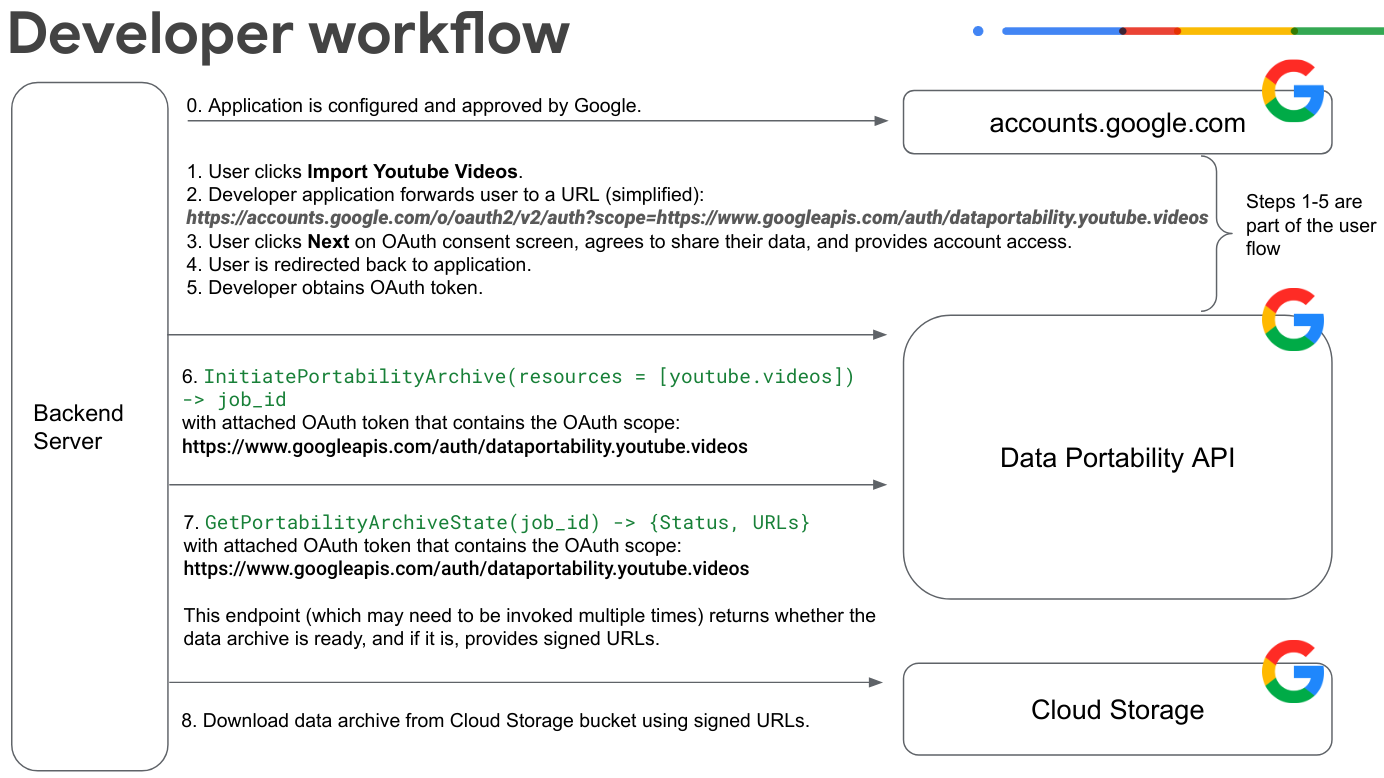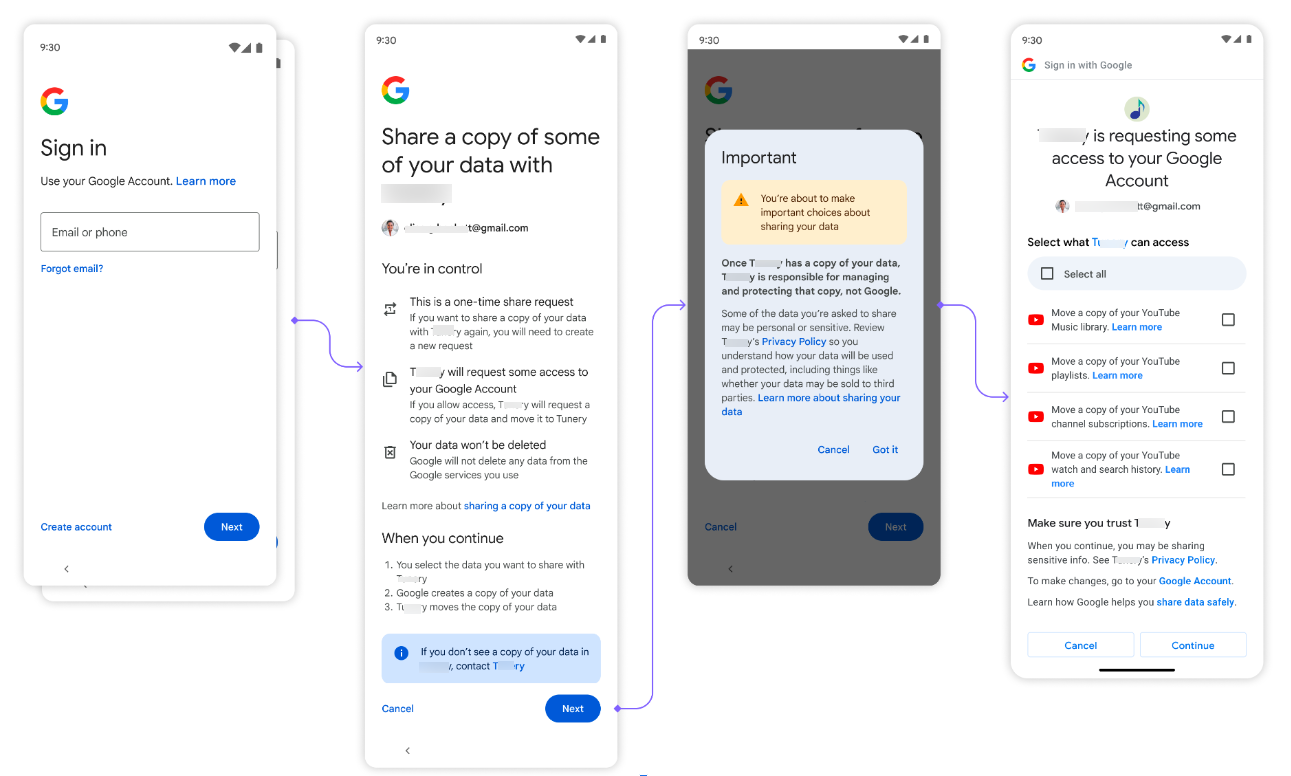Data Portability API به شما امکان میدهد برنامههایی بسازید که درخواست مجوز از کاربر برای انتقال یک نسخه از دادهها از سرویسهای Google به برنامه شما میدهند. این قابلیت حمل داده ها را ممکن می کند و خدمات سوئیچینگ را تسهیل می کند.
اگر به دنبال اطلاعاتی در مورد نحوه اشتراکگذاری دادهها توسط کاربران هستید، به اشتراکگذاری یک کپی از دادههای خود با شخص ثالث مراجعه کنید.
پیش نیازها
قبل از انتشار برنامه، باید توسط Google تأیید شود.
همچنین باید بررسی کنید که Data Portability API برای کاربرانی که در مکان شما هستند در دسترس است. برای فهرستی از کشورها و مناطق پشتیبانی شده، به سوالات متداول در صفحه "به اشتراک گذاری یک نسخه از داده های خود با شخص ثالث" مراجعه کنید.
گردش کار برنامه نویس
این مراحلی است که برای ایجاد برنامه ای که از Data Portability API استفاده می کند، دنبال می کنید.

جریان رضایت OAuth را برای کاربر اجرا کنید. در این مثال، کاربر امکان دسترسی به داده های ویدیوی YouTube را فراهم می کند.
کاربر روی Import Videos YouTube کلیک می کند و به حساب Google خود وارد می شود.
برنامه کاربر را به URL رضایت OAuth هدایت می کند. توجه داشته باشید که این URL مثال ساده شده است و برخی از پارامترها را ندارد:
https://accounts.google.com/o/oauth2/v2/auth?scope=https://www.googleapis.com/auth/dataportability.myactivity.youtubeکاربر روی Next در صفحه رضایت OAuth کلیک می کند، با اشتراک گذاری داده های خود موافقت می کند و دسترسی به حساب را فراهم می کند.
کاربر انتخاب میکند چه دادههایی را به اشتراک بگذارد و مدت زمانی را که برنامه میتواند به آن دادهها دسترسی داشته باشد ( دسترسی یکباره به دادههای خود یا دسترسی مبتنی بر زمان برای 30 یا 180 روز)، سپس روی Continue کلیک میکند.
توجه : تا 90 روز قبل از انقضای توکن OAuth شما، کاربر میتواند دسترسی شما به دادههای خود را قبل از منقضی شدن توکن OAuth تمدید کند. اگر کاربر محدوده های منقضی در 90 روز را نداشته باشد، دکمه تمدید ظاهر نمی شود.
توجه : اگر کاربر بخواهد بین دسترسی یکباره و دسترسی مبتنی بر زمان جابجا شود، باید پس از لغو اعطای موجود، دوباره جریان رضایت را طی کند. میتوانید با
resetAuthorization()این کمک مالی را لغو کنید، یا کاربر میتواند در صفحه اتصالات خود لغو کند.کاربر به برنامه هدایت می شود.
توسعه دهنده یک نشانه OAuth برای کاربر دریافت می کند.
برنامه شما
InitiatePortabilityArchive(resources = ["myactivity.youtube"])را با یک نشانه OAuth پیوست که حاوی این محدوده OAuth است فراخوانی می کند:https://www.googleapis.com/auth/dataportability.myactivity.youtubeاین فراخوان فرآیند ایجاد آرشیو داده ها را آغاز می کند و با شناسه شغلی و اینکه آیا کاربر به کاربر دسترسی یکباره یا مبتنی بر زمان داده است، پاسخ می دهد.
توجه : دسترسی یکباره به معنای یک صادرات در هر محدوده است. اگر کاربر دامنه های متعددی را اعطا کند، می توانید شغل های جداگانه ای برای هر یک از منابع مجاز توسط توکن ایجاد کنید.
برنامه شما
GetPortabilityArchiveState(job_id)با یک نشانه OAuth پیوست شده که شامل این محدوده OAuth است فراخوانی می کند:https://www.googleapis.com/auth/dataportability.myactivity.youtubeبرای بازیابی وضعیت کار بایگانی می توانید چندین بار با این روش تماس بگیرید. متد وضعیت کار را برمی گرداند. اگر وضعیت
COMPLETEباشد، بایگانی آماده است و نشانیهای اینترنتی ذخیرهسازی ابری امضا شده ارائه میشوند. توجه داشته باشید که زمان تکمیل درخواست بایگانی بسته به اندازه داده ها می تواند از چند دقیقه تا چند ساعت متفاوت باشد.بایگانی داده ها را با استفاده از URL های امضا شده دانلود کنید.
اگر کاربر یک بار دسترسی اعطا کند ، شما
ResetAuthorization()با یک توکن OAuth پیوست شده برای بازنشانی منابع تمام شده و حذف همه رضایتهای OAuth فراخوانی میکنید.اگر کاربر دسترسی مبتنی بر زمان را اعطا کند ، میتوانید هر 24 ساعت منابع را صادر کنید تا زمانی که رضایت منقضی شود.
برای اطلاعات بیشتر در مورد استفاده از روشهای API انتقال داده، به روشهای API انتقال داده تماس بگیرید .
نحوه تعامل کاربران با یک برنامه API Portability Data
این نمودار نحوه تعامل کاربران با برنامهای که با Data Portability API یکپارچه شده است را نشان میدهد.

ابتدا گزینه ای برای بازیابی اطلاعات به کاربر ارائه می شود.
در مرحله بعد، کاربر وارد حساب Google خود می شود.
سپس، وقتی از کاربر خواسته میشود دادههای خود را به اشتراک بگذارد، روی Next کلیک میکند، و وقتی از او خواسته میشود که خطمشی رازداری را بپذیرد، روی من میفهمم کلیک میکند.
سپس، یک صفحه رضایت OAuth به کاربر نشان داده میشود که از آن برای دسترسی برنامه به دادههایش استفاده میشود. گزینههای اینجا با دامنههای OAuth که پیکربندی کردهاید مطابقت دارند. کاربر انتخاب میکند چه دادههایی را به اشتراک بگذارد و مدت زمانی را که برنامه میتواند به آن دادهها دسترسی داشته باشد ( دسترسی یکباره به دادههای خود یا دسترسی مبتنی بر زمان برای 30 یا 180 روز)، سپس روی Continue کلیک میکند.
پس از اجازه دسترسی، وارد کردن داده ها شروع می شود. بسته به اندازه داده ها، تکمیل درخواست ممکن است چند دقیقه تا چند ساعت طول بکشد.
